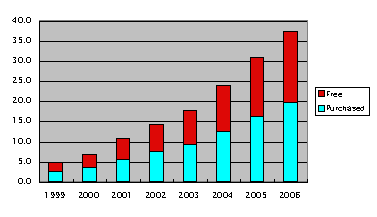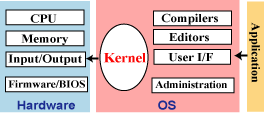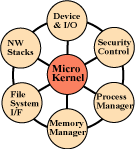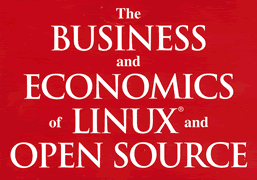Summary |
要約 |
>Top
0. Prologue:
- Linux is a product of a community including Linus Torvalds and
many other volunteers. I'd like mention some of the famous names
mention at the LinuxWorld.
- A bunch of Linux Geeks:
Linus Torvalds, Jon "maddog" Hall, David "DOC"
Searls, Eric S. Raymond, Marc Torres, Larry Augustin, Brian Biles,
Greg Zehr, Rob Glasser, Jeff "Hemos" Bates, Tim O'Reilly,
Bruce Perens, Marc Ewing, Thomas Butta, Geoff "Manddrake"
Harrison, John H. Terpstra, Dan Frye, Scott Handy, Carsten 'Raster'
Haitzler, San 'Nettwerk' Mehat, Michael Tiemann, Chirs DiBona, Ransom
H. Love, Benoy Tamang, Don Hansen, Lyle Ball, Bryan Sparks, Fernand
D. Sarrat, Arthur F. Tyde III, David L. Sifry, Dvid Mandala, Chirs
Kolar, Sam Ockman, Jon Kats, Rob "CmdrTaco" Malda, Phil
Hughes, Peter Salus, Brian Proffitt, Steve Crocker, Vint Cerf, John
Quarterman, Bryon Bertrim, Mac Brown, Dan York, Scott Draeker, Camron
Cooper, Brock Meeks, Bill Parish, Brian Frank, Laurent Meynier,
Eric Lefevre, Robin Ford, John Taschek, Arne Flones, Deepak Saxena,
Trae "" McCombs, ....
|
0. プロローグ:
- LinuxはLinus Torvaldsやその他大勢のボランティアの参加するコミュニケーションティの製品である。以下にそのLinuxコミュニティの有名人達をLinuxWorldからの情報で列挙してみる。
- Linuxオタク列伝:
Linus Torvalds, Jon "maddog" Hall, David "DOC"
Searls, Eric S. Raymond, Marc Torres, Larry Augustin, Brian Biles,
Greg Zehr, Rob Glasser, Jeff "Hemos" Bates, Tim O'Reilly,
Bruce Perens, Marc Ewing, Thomas Butta, Geoff "Manddrake"
Harrison, John H. Terpstra, Dan Frye, Scott Handy, Carsten 'Raster'
Haitzler, San 'Nettwerk' Mehat, Michael Tiemann, Chirs DiBona, Ransom
H. Love, Benoy Tamang, Don Hansen, Lyle Ball, Bryan Sparks, Fernand
D. Sarrat, Arthur F. Tyde III, David L. Sifry, Dvid Mandala, Chirs
Kolar, Sam Ockman, Jon Kats, Rob "CmdrTaco" Malda, Phil
Hughes, Peter Salus, Brian Proffitt, Steve Crocker, Vint Cerf, John
Quarterman, Bryon Bertrim, Mac Brown, Dan York, Scott Draeker, Camron
Cooper, Brock Meeks, Bill Parish, Brian Frank, Laurent Meynier,
Eric Lefevre, Robin Ford, John Taschek, Arne Flones, Deepak Saxena,
Trae "" McCombs, ....
|
>Top
1. Linux Adoption:
- Linux adoption (IDC 2002):
Linux itself can be obtained for free. But, having an approximate
view of the copies in use gives an indicator of associated product
revenues, such as clients, software, storage, etc. This chart gives
a view of how first Linux has been growing. You should infer from
this that companies will shift future product investments to Linux
to take advantage of this growth.
<# of copies (both free and purchased)
of Linux operation environments is use.>
- Open Source Lingo:
- Kernel:
the heart of of the operation system. Linux is in fact a kernel,
not an operating system.
- GNU (Gnu is Not Unix):
GNU system represents many of other parts (compiler, tools,
editors, etc.) It should be referred to as GNU/Linux system.
- Distribution:
Common Linux distribution vendors are Red Hat, SuSE, Debian,
Mandrake, Connectiva, and Red Flag.
- Package:
Since many packages can share the same set of files, complex
interdependencies are managed by installation and deployment
tools.
- Free software:
Free signify freedom, as in free speech, and not to characterize
without cost. Everyone should have equal access to source code.
- Open source:
Open source is not a license. It provides a common set of specifications
to which licenses must adhere to be considered open source.
- Community:
Any collection of software developers working collaboratively
on a software project.
- Maintainer:
The individual, committee, board of directors, or foundation
that accepts or rejects code changes into an open source project.
- GPL (GNU general public license):
The GPL requires that any modifications to the source base be
returned to the community at large.
|
1. Linuxの採用:
- Linuxの採用 (IDC 2002):
Linux自体はタダである。しかし利用ソフトの実体を見るとクライアント、ソフトウェア、ストレッジなど関連の売上がある。この図はLinux導入の急成長を示す。この図からは、企業はこの成長を取り込むためには、Linuxに対する将来投資を当然すべきという帰結になる。
左図:<Linux使用環境でのLinuxおよび商用ソフト利用コピー数>
- オープンソース用語:
- カーネル:
OSの中心部。Linuxは正しくはカーネルであって、OSではない。
- GNU:
GNUシステムはコンパイラ、ツール、エディターなど多くの部品を含む。これはGNU/Linuxシステムと呼ばれる。
- デストリビューション:
Red Hat, SuSE, Debian, Mandrake, Connectiva, Red FlagなどのLinuxのディストリビューション・ベンダーをいう。
- パッケージ:
多くのパッケージには共通のファイルをもつので、インストールの場合のツールなどによって相互運用を管理する。
- フリーソフトウェア:
ここでフリーとはフリースピーチの場合のように自由という意味でタダという意味ではない。誰もがソースコードに等しくアクセスできるのである。
- オープンソース:
オープンソースとはライセンスではない。これはオープンソースとして遵守しなければならないライセンスの共通の使用を提供する。
- コミュニティ:
ソフトウェアプロジェクトで協業するソフトウェア開発者の集団をいう。
- メインテナー:
オープンソースプロジェクトとしてのコード変更を承認あるいは拒否する個人、委員会、役員会、あるいは協会をいう。
- GPL (GNU general public license):
GPLは、ソースベースのいかなる変更も全体としてコミュニティに戻すことを要求する。
|
>Top 2. Benefits of Linux:
- Here are some of the key business benefits of Linux:
- Cost:
Linux can be freely copied, subject to reasonable license terms,
without payment of royalties.
- Availability of Trained Resources:
Linux is now more than 10 years old and so trained resources
are available. As your enterprise grows and you need more talented
personnel to run your network infrastructure, application servers
, and data center, Linux-capable talent will be one the most
readily available resources.
- Support:
The ability of to get guaranteed support is questionable. But
since the code is available to all, anyone can provide
support and self-support become a lower cost and more
viable option.
- Control and Vendor Independence:
Linux is the first viable combination of a commodity OS on commodity
hardware (eg. IA-32 architecture). Companies have the choice
to mix and match hardware and peripherals since a large ecosystem
develops around commodity products.
- Software Development:
Linux has become the primary platform for Fluent development
team. Fluent is a leading vendor of CAE software solutions.
- Upgrades:
Much of the motivation for the upgrades is due to hardware and
licensing requirements by various vendors. With Linux,
you have the option to consider the costs of self-support, buying
support, or doing upgrades and making the best set of tradeoffs
for your business.
|
2. Linuxのメリット:
- Linuxのビジネス上の主なメリットは以下である。:
- コスト:
Linuxはライセンス条件次第では、追加費用なしでコピー自由。
- 熟練の人材:
Linuxは十年の歴史があり、習熟人材の活用が可能。企業の拡大に伴い、ネットワークインフラ、アプリケーションサーバ、データセンタ活用のためにはLinuxの熟練技術者が必要となるがその供給源あり。
- サポート:
保証されたサポートを得ることは疑問であるが、一方ではコードが公開されているので、誰でもサポートを提供できるし、自己サポートをすれば安価に済むという選択肢もでてくる。
- 管理およびベンダーからの独立:
Linuxは、 (IA-32アーキテクチャのような) コモディティのハードの上にコモディティのOSという実質的には初の組み合わせである。企業はコモディティ製品の周辺に巨大な生態系というべきハードや部品群を組み合わせるという選択肢を持つ。
- ソフトウェア開発:
LinuxはFluentな開発チームにとって主要なプラットフォームになった。FluentとはCAEソフトの主要な開発ベンダーのことである。
- アップグレード:
アップグレードする多くの理由は種々のベンダーによるハードやライセンス上の要求に依る。Linuxの場合はサポートを自分で行うか、委託するか、あるいはアップグレードをするかどうかについてもビジネス上の功罪を加味して自分で決められる。
|
>Top 3. Application Availability:
- Apache Web Server:
Linux owes much of the success to one killer open source application:
The Apache Web server was being used by more than 50% of sites on
the Internet. (2001)
- Development environment:
ISVs have had to maintain multiple development environments of each
of their UNIX platforms. Many are shifting to Linux as their core
development environment and using it as the base port for all other
platforms.
- Large hardware & software companies support:
BEA, Dell, HP, IBM, Oracle, SAP, and many others are making products
available on Linux.
- Maturity:
10 years is actually very young. But LInux has a solid and proven
track record in the Internet infrastructure. Another maturity as
'enterprise-readiness': tools not available or very early in their
stages of development. Vendors and the open source community are
working diligently to fill these gaps.
- Scalability:
Vertical scalability by adding processors allows Linux to scale
its performance. With release of Linux 2.4 kernel, scalability to
16 processors is possible. (Cf: today's UNIX systems will often
scale to 128 processors and beyond.)
- Horizontal scalability combining a large number of low-cost
systems has been one of the great strength of Linux.
- But the changes to the kernel involve difficult tradeoffs
between complexity and capability.
|
3. 有用なアプリケーション:
- Apache Webサーバ:
Linuxはひとつのキラーアプリケーションに大きく依存している。Apache Webサーバは、過半数のインターネットサイトで利用されている。
(2001)
- 開発環境:
ISVは各UNIXプラットフォームに対応する多くの開発環境を維持してきた。その多くは中心的な開発環境としてLinuxへシフトしてそのほかのプラットフォームのベースにしつつある。
- 大企業ベンダーによるサポート:
BEA、Dell、HP、IBM、Oracle、SAPのような大手がLinux対応の製品を作っている。
- 成熟度:
10年の歴史は長くはない。しかしLinuxはインターネット・インフラでは確固たる実績がある。その他に企業対応の習熟度がある。ツール類はないかあっても初期段階のものでしかない。しかしベンダーやオープンソースコミュニティはこのギャップを埋めるべく熱心に開発している。
- 拡張性:
プロセッサを追加することでの縦の拡張性によってLinuxのパフォーマンスは向上する。Linux 2.4の発表によって16プロセッサーまでの拡張できるようになった。
(但し、今日のUNIXシステムは128プロセッサあるいはそれ以上まで拡張可能である。)
- 安価なシステムを大量につなげることによる横の拡張性はLinuxの強みの一つである。
- 一方、カーネルを変更することは、複雑性と処理能力との間に困難なトレードオフの課題を包含することにもなる。
|
>Top 4. Timeline &
Who's who of Linux:
- 1984: Free Software Foundation (FSF) is formed.
- 1991: The first code for Linux is released.
- 1994: Linux 1.0 is released. Red Hat is founded.
- 1996/6: Linux 2.0 is released
- 1997/5: 'The Cathedral and the Bazaar' is published.
- 1998/2: Open Source is coined.
- 2001/1: Linux 2.4 is released.
- Who's who:
- Linus Torvalds:
is the creator and maintainer of Linux.
- Alan Cox:
was considered Linus' top lieutenant until 2001; still commands
tremendous influence within the community.
- Marcelo Tosatti:
Linus and Alan transferred the maintenance torch of the stable
Linux to Marcelo.
- Dave Miller:
is the developer who will check the networking stacks in the
Linux kernel.
- Richard Stallman:
is the founder of the FSF, and is also the creator of the GNU.
- Bruce Perens:
is the project leader for the Debian project. He authored a
'Social Contract,' and 'Open Source Definition (OSD).'
- Eric Raymond:
is an anthologist and thought leader.
- Larry Augustin:
is CEO of VA Software Corp, who was originally incorporated
as VA Linux System.
- Tim O'Reilly:
is President of O'Reilly Books, and continue to have a tremendous
influence on the open source movement.
- Brian Behlendorf:
is the co-founder of the Apache Software Foundation.
- Michael Tiemann:
founded Cygnus Solutions, which was acquired by Red Hat in 2000.
- Bob Young:
is credited with the success of today's most popular Linux distribution,
Red Hat.
- Jeremy Allison:
is the leader of SAMBA project, which is key interoperability
technology.
- Miguel de Icaza:
is a founder of Ximian Corp, and a founder of Mono, which is
an open source implementation of a subset of .NET framework.
|
4. Linux年表と開発者列伝:
- 1984: フリーソフトウェア協会(FSF)設立
- 1991: 最初のLinuxコード発表
- 1994: Linux 1.0発表
- 1996/6: Linux .20発表
- 1997/5: 「カテドラルとバザール」出版
- 1998/2: 「オープン・ソース」の言葉作成
- 2001/1: Linux2.4発表
- Linux人名録:
- Linus Torvalds:
Linuxの創始者かつ維持者
- Alan Cox:
Linusの右腕(2001まで)、現在もコミュニティ内で絶大な影響力あり。
- Marcelo Tosatti:
LinusとAlanから安定的なLinux維持のためにバトンタッチされた。
- Dave Miller:
Linux カーネルでのネットワーク・スタックを審査する開発者
- Richard Stallman:
FSFの創始者、かつGNUの発明者
- Bruce Perens:
Debianプロジェクトのリーダ。またSocial ContractやOpen Source Definition (OSD)を創始者。
- Eric Raymond:
人類学者かつLinux思想伝道者
- Larry Augustin:
VA Software CorpのCEOで、VA Linuxシステムを具体化
- Tim O'Reilly:
O'Reilly書店の社長で、引き続きオープンソース運動では絶大な影響力をもっている。
- Brian Behlendorf:
Apache Software Foundationの共同創立者の一人。
- Michael Tiemann:
Cygnus Solutions社の創設者。後2000年にRed Hatに買収された。
- Bob Young:
今日最も人気のあるLinuxディストリビュータであるRed Hatの創設者
- Jeremy Allison:
相互運用技術であるSAMBAプロジェクトのリーダ。
- Miguel de Icaza:
Ximian Corpの創始者、また.NET環境でのサブセット環境下でのオープンソース利用する'Mono' (サルの意)
の創始者
|
>Top 5. GNU/Linux system:
- Linux is only the kernel, the core foundation that keeps an overall
system functioning properly.
- Richard Stallman frequently asserts that Linux total system
should be called GNU/Linux system.
- However, there are other components such as X11 windowing system,
desktop interfaces, file-sharing interoperability tools, etc.
are also usually delivered with Linux.
- Operating System (OS):
 There
is no fully accepted standard of OS. There
is no fully accepted standard of OS.
When networking was still new, core networking stacks (such as TCP/IP)
was sold as add-ons
- OS is the link between the application and the resources (hardware
component).
- Resource utilization in Linux can be thought of in three dimensions:
1) management, 2) administration, and 3) control. Here, management
provides computer resources available, administration
tools configure these available resources, and the
kernel controls available resources based on its design
and configuration.
- Micro Kernel:
 Micro
kernel break apart most of the key control functions (such as Device
& I/O, Network stacks, File system interface, Memory manager,
Process manager, and Security control. Rather than state information
being available to all functions, messages are passed from one function
to another. Micro
kernel break apart most of the key control functions (such as Device
& I/O, Network stacks, File system interface, Memory manager,
Process manager, and Security control. Rather than state information
being available to all functions, messages are passed from one function
to another.
- Linux Kernel Patches:
Just as modules provide a mechanism to add new functionality
to the Linux kernel, patches provide a way to extend or change
kernel functionality. Patches are often thought of as a mechanism
to repair defects. With Linux, patches are also used to change
or add functionality to the kernel.
- Linux Version Control:
New kernel version in development are issued an odd number for
the sub-version number. Kernel versions 2.1.x, 2.3.x, and 2.5.x
are all kernels that have been, or are, under development. Kernel
versions with even sub-numbers, such as 2.0.x, 2.2.x, and 2.4.x,
are all released kernels considered ready for production.
After a kernel has been released and stabilized, Linux Torvalds
will initiate a new development cycle. The kernel community
will assemble to determine the list of features that will comprise
the next release of the kernel.
- Non-mainstream processors:
In addition to the x86 (IA-32), the linux kernel is available
on other alternative architectures:
- AMD'S Opteron
- HP's PA-RISC and Alpha
- IBM's PowerPC and S/390
- Intel's Itanium
- Motorola's 68K
- SUN's SPARC
|
5. GNU/Linuxシステム:
- Linuxは、すべてのシステムがうまく機能するためのコアとなるカーネルだけである。
- Richard Stallmanは、しばしばLinuxの全システムは、GNU/Linuxシステムと呼ばれるべきであると主張している。
- 但し、X11ウインドウシステム、デスクトップインターフェイス、ファイル共有のインターオペラビリティのツールなどのようにLinuxを一緒に配布される他の要素もある。
- オペレーティング・システム (OS):
OSの標準が何かについては全面的な合意はない。
ネットワークがまだATAらしかった時は、TCP/IPのようなネットワーキング・スタックはAdd-onとして販売されていた。
- OSはアプリケーションとハード資源とのリンクの機能である。
- Linuxのリソース活用は、以下の三次元から成っている。1) マネジメント、2) アドミニストレーション、および3)
コントロールである。マネジメントはコンピュータ資源を使用可能(available)にし、アドミニストレーションはこの使用可能な資源を配置(configure)し、そしてカーネルのはその設計に基づき配置された資源をcontrolする。
- マイクロ・カーネル:
マイクロカーネルは多くの主なコントロール機能を分割する。例えばデバイスとI/O、ネットワーク・スタック、ファイル・システム・インタフェース、プロセス・マネジャなどである。これは状況情報をすべきの機能で使用可能とするより、ある機能から別の機能へとメッセンジャーが情報を伝えるのである。
- Linux カーネル・パッチ:
モジュールがLinuxカーネルに新たな機能を追加する機構を提供するように、パッチはカーネルの機能を拡張したり変更したりする方法を提供する。パッチはしばしば欠点を修復する機能と見なされている。Linuxにおいては、パッチはカーネルの変更や機能追加としても利用される。
- Linuxバージョン管理:
開発中の 新たなカーネルバージョンは奇数のサブ番号で公表される。つまりカーネルバージョンが2.1.x、2.3.x、2.5.xなどすべて開発中段階である。偶数のサブ番号のカーネルバージョン、つまり2.0.x、2.2.x、2.4.xなどはすべて製品としてのカーネルである。一つのカーネルが発表され安定化するとLinux
Torvaldsは新たな開発段階へ着手する。カーネル・コミュニティとして会合し、次期カーネルの発表に含まれる機能リストを決定する。
- その他のプロセッサ対応:
インテルx86 (IA-32)以外にも、Linuxカーネルが以下のアーキテクチャで利用可能である。
- AMD'S Opteron
- HP's PA-RISC and Alpha
- IBM's PowerPC and S/390
- Intel's Itanium
- Motorola's 68K
- SUN's SPARC
|
>Top 6. Desktop Linux:
- Desktop Linux:
- Share: Desktop Linux is less than 2%.
Application availability, end-user friendliness, migration and
retaining costs make it difficult for most enterprises to consider
deployment on their desktops.
- High-end imaging applications, such as the entertainment industry
and medical imaging markets, are also attracted to the Linux
desktop.
- Linux delivers a UNIX experience for the end-user with a cost
profile similar to PC deployments.
- The open source community has already delivered two primary
desktop interface:
- GENOME desktop: For GENOME it is GTE
- K-Desktop Environment (KDE): For KDE it is Qt.
- GENOME and KDE are the equivalent of the Common Desktop
Environment (CDE). For CDE the API was Motif.
- StarOffice and OpenOffice:
StarOffice is offered by SUN, and OpenOffice is an open source
implementation of StarOffice.
|
6. デスクトップLinux:
- デスクトップLinux:
- Desktop Linuxのシェアは2%以下。利用可能なアプリケーション、ユーザの慣れ、移行や維持経費が大きく企業にとって普及が進まない原因である。
- 高性能の画像処理分野、例えば映像産業や医療画像の分野ではLinuxデスクトップは好評である。
- Linuxは、ユーザにとっては、ほぼPCの導入の価格でUNIXでの経験を活用できる。
- オープンソース・コミュニティはすでに2つの主要なデスクトップのインターフェイスを提供している。
- GENOMEデスクトップ
- K-Desktop 共通のデスクトップ環境 (CDE)として2つのデスクトップインターフェイスを提供している。GENOMEとKDEである。
- StarOfficeとOpenOffice:
StarOfficeはSUNが提供し、OpenOfficeはStarOfficeのオープンソース版である。
|
>Top 7. Scalability:
- Vertical Scaling and Horizontal Scalability:
- Vertical Scaling:
One large system with a single operating system image.
- Horizontal Scaling:
Large number of systems, each with its own operating system
image.
- 2.4 Kernel:
It was a significant leap forward for multiprocessor (or vertical)
scalability.
- Embedded Linux:
- The ability to customize the Linux kernel makes it an ideal
environment for embedded applications. It is possible to build
a scaled down, limited functionality kernel that runs in 1MB
of RAM.
- Since many embedded applications involve the deployment of
million of units, eliminating the need for royalty fees based
on volume makes Linux an attractive choice.
|
7. スケーラビリティ:
- 垂直的と水平的スケーラビリティ:
- 垂直的スケーラビリティ:
単一のOSを搭載する単一の大きなシステム
- 水平的スケーラビリティ:
各々がOSをもつシステムの大きな数の集合
- 2.4カーネル:
マルチプロセッサへの対応としては大きな進歩
- 組込Linux:
- Linuxカーネルをカスタマイズできることが組込アプリケーションにとって理想的な環境である。また機能を制限したりして1MB
RAMでカーネルを動かすことができる。
- 多くの組込アプリケーションはユニット数が多いので、ライセンス使用料がかからないLinuxは魅力的な選択肢となる。
|
>Top 8. What is Open
Source?:
- As a technology leader, you
need to become an expert on open source. It presents opportunity
since it give you new ways to lower costs and create competitive
advantage. Open source also creates a threat by exposing your business
to significant intellectual property risk.
- Freedom and open source:
The word 'free' means the freedom to copy, modify, and distribute
the software, and does not mean at no cost.
- The Open Source Definition:
The rights are codified formally in an OSD (Open Source Initiative), a non-profit corporation. It is important
to understand that the OSD is not itself a license. Below is a
summary of 9 items provided by OSD*
- Free redistribution
- Source code
- Derived works
- Integrity of the author's source code.
Some open source licenses require modifications to be made
through patches, so that the original source is distributed
unmodified, and then the modifications are provided in a separate
patch file.
- No discrimination against person or groups
- No discrimination against field of endeavor
- Distribution of license
- License must not be specific to a product.
- License must not contaminate other software.
OSD cannot force its license terms on other software distributed
with it. Thus encourages companies to distribute both open
source and proprietary software on the same CD.
- Open source licenses, including GPL:
- Non-open source incense often mistaken for open source:
- Open source and US cryptography export laws:
- Open source development methodology:
- Intellectual Property and Reciprocity:
- Copyleft:
To copyleft a program, the software is first copyrighted, and
then the software is distributed under a incense, a legal instrument
that gives everyone the rights to use, modify, and redistribute
the programs's code or any program derived from it but only
if the distribution terms are unchanged.
- Reciprocity:
Reciprocity obligations don't arise by the sue of software;
they only arise when the modified (or improved) software is
distributed.
- Dual-Licensing:
Any copyright owner can license copyedited software under more
than one lines. For some open source software, the licensor
allow you to elect to license the software under either a reciprocal
open source license (like GPL) or under a commercial license.
|
8. オープンソースとは:
- 技術リーダとしては、オープンソースに習熟する必要がある。これは新たにコストを下げて、競争優位を創り出す機会となるからである。オープンソースはまた知的所有権を巡って既存ビジネスの驚異となり得る。
- 自由とオープンソース:
ここでいうフリーとはソフトウェアのコピー、修正、および配布が自由という意味であって、コストが料金がタダという意味ではない。
- オープンソースの定義:
この権利は非営利団体であるOSD (Open Source Initiative)によって成文化されており、以下の9項目が規定されている。
- 自由な再配布
- ソースコード
- 派生的作品
- 原ソースコードの統一性
一部のオープンソース・ライセンスはパッチによる修正を必要とするようにすれば原ソースは変更なし配布可能となる。修正部分は独立のパッチファイルに規定される。
- いかなる個人団体に対しても非差別的
- いかなる貢献分野に対しても非差別的
- ライセンスの配布
- ライセンスは特定製品に限定されない
- ライセンスは他のソフトウェアを包含しない。
OSD条件としては、同梱される他のソフトウェアのライセンス条件を拘束しない。こうすることで同じCD媒体でオープンソースと独自ソフトとを同梱しても問題ない。
- GPLなどオープンソース・ライセンス:
- オープンソースと誤解される非オープンソース
- オープンソースと米国の暗号輸出法:
- オープンソース開発の手法:
- 知的所有権と相互主義:
- コピーレフト:
プログラムをコピーレフトにするためには、そのソフトのコピーライトを取得する。その後、そのソフトを誰もが自由に利用、修正、再配布できるようなライセンス条件として配布する。但しそのソフトおよび派生したソフトのいかなるコードも変更することなく配布可能とする。
- 相互主義:
相互主義の義務はソフトの利用によって発生はしない。それは修正 (改良) ソフトを配布する場合に生じる。
- 二通りのライセンス方法:
どのコピーライト・オーナーもコピーライトのソフトを2つ以上のライセンスを行うことができる。一部のオープンソースで、ライセンサーは(GPLのように)
相互的なオープンソースとしてライセンスするか、商用のライセンスにするか選択できる。
|
>Top 9.
Open Source and Non-Open Source (オープンソースと非オープンソース) :
- Popular Open Source Incenses
License |
Copyleft |
Comments |
| Apache |
No |
used by Apatch Web Server; similar to MIT and BSD. |
| Artistic |
No |
develped for Perl language. |
| BSD |
No |
BSD incense allows you to make the code private and then
distribute it under a proprietary license. |
| GNU General Public (GPL) |
Yes |
used for Linux kernel. |
| GNU Lesser General (LGPL) |
Yes |
Similar to GPL, but allows you to link non-free software
to LGPL code. |
| IBM Public License |
Yes |
similar to Mozilla Public License |
| Mozilla Public License (MPL) |
Yes |
open source version of Netscape Navigator. |
| MIT License |
No |
A very simple incense that has virtually no restriction
on how the source is used. The text of the license must be
included in all copies. |
| Python License |
No |
an interpreted, object-oriented programming language within
in Linux. |
| Qt Public Licene (QPL) |
Yes |
a development library of KDE desktop environment; similar
to Motif in functionality. |
| SUN Industry Standards Source License (SISSL) |
No |
apply to XML file format spec. and Open Office API spec. |
- Non-Open Source Incenses:
These licenses do not meet the requirements of the OSD.
License |
Comments |
| Microsoft Shared Source |
provides access to source, but requires to return changes
you make back to MS. |
| Netscape Public License (NPL) |
Until Mozilla provided a true open source code base for
the browser, NPL gave Netscape a way to release the code. |
| SUN Community Source License |
is also a form of a shred source increase; different from
SISSL. |
|
>Top 10. Attributes of
Open Source:
This set of characteristics is the foundation of an important culture
that drives community behavior.
- Maintainer:
Most projects are run by a maintainer. The maintainer is the individual
who initiated the project, or who was assigned by a previous maintainer.
Maintainers are always volunteer.
- Respect:
Built over time, and by ongoing contributions, respect for the individual
is paramount in the open source development community. The community
tends to be equally vocal with praise and criticism. Continuous,
high-quality contributions will build respect over time.
- Individuals as maintainers:
Even tough companies will often fund and promote open source projects,
the maintainer is often an individual.
- Tools:
CVS is a well-accepted source management tool and Bugzilla is most often used for defect tracking. SourceForge, and now Savannah,
provide a development infrastructure and repositories.
- Release early and often:
Rapid and ongoing release cycle allows a team of developers to quickly
recognize defects and address them early in the development process.
- Release for production when ready:
The community generally release to production when the maintainer
think the product is ready. Those who accept this immediately begin
to benefit from high qualtiy software, fewer patches, and a better
system architecture.
|
10. オープンソースの属性:
- 以下の特徴は、オープン・コミュニティを規定する重要な文化基盤である。
- 維持管理者:
ほとんどのプロジェクトは維持管理者によって実行される。維持管理者はプロジェクトを開始した個人あるいは前任の維持管理者を引き継いだ者である。維持管理者は常にボランティアである。
- 尊敬:
長い間の継続的な貢献によって、オープンソース開発コミュニティにおける個人に対する尊敬が確立される。コミュニティは賞賛と批判を発言するに当たって平等が重んじられる。継続的かつ上質な貢献が自然と尊敬につながる。
- 維持管理者としての個人:
企業はオープンソースプロジェクトを資金提供し推進することがあるが、維持管理者は個人である。
- ツール:
CVSはソース管理ツールとして使用され、Bugzilla はディフェクト・トラッキングによく利用される。SourceForge、今はSavannahが開発インフラおよびリポジトリーを提供する。
- 早期にそして頻繁にリリース:
早期のそして継続的な発表サイクルは開発チームに早く欠点を認識させ、開発プロセスでの早期の対処させる。
- 準備次第、製品をリリース:
コミュニティは原則として、維持管理者が製品として準備でき次第製品を発表する。この製品をすぐ受領することによってパッチのより少ないより良いシステムアーキテクチャを享受できる。
|



 There
is no fully accepted standard of OS.
There
is no fully accepted standard of OS. Micro
kernel break apart most of the key control functions (such as Device
& I/O, Network stacks, File system interface, Memory manager,
Process manager, and Security control. Rather than state information
being available to all functions, messages are passed from one function
to another.
Micro
kernel break apart most of the key control functions (such as Device
& I/O, Network stacks, File system interface, Memory manager,
Process manager, and Security control. Rather than state information
being available to all functions, messages are passed from one function
to another.